Quick SEO Wins: Getting Fast Results with Smart SEO Tactics
“But how long until we see results?”
Ever heard this question before?
Sure you have, especially if you manage SEO clients. While the honest answer might be “it depends” or “at least several months,” that’s not what clients usually want to hear.
Still, you don’t always have to wait months on end to see a measurable impact from your SEO efforts.
This guide shows you exactly where to find quick SEO wins so you can keep clients happy and engaged. You’ll learn how to demonstrate value fast, and without compromising on sustainable growth.
-
Identify low-hanging fruit SEO opportunities
Some main ones include focusing on pages with easy-to-improve positions, improving CTR for top-performing pages, fixing keyword cannibalization issues, and identifying (and optimizing for) newly ranking competitor keywords in organic search.
-
Fix site-wide technical issues
Look for issues that can be resolved with simple adjustments like updating templates, fixing site-wide elements, or improving CMS configuration.
-
Implement low-effort on-page SEO fixes
For instance, you can do this by identifying and boosting pages with declining impressions or clicks, low CTR in top results, or poor-quality content.
-
Power up high-priority pages by adding internal links and rebuilding lost backlinks
Boost visibility by building internal links to high-converting pages and those nearing the top 10. Reclaim lost backlinks to restore traffic and improve search performance.
-
Target long-tail keywords with lower competition and higher conversion rates
Focus on long-tail keywords with relevant search intent and low competition to drive qualified traffic and conversions.
-
Claim and fully optimize your Google Business Profile
Keep your NAP (name, address, phone number) consistent across directories, and use GBP posts to engage customers directly in search results and on Google Maps.
-
Support your SEO strategy with paid advertising
Use paid advertising to show immediate value to clients and build trust while boosting your organic SEO efforts.
How to get fast SEO results
Most SEO experts agree that it takes 6-12 months to see significant results, especially for highly competitive niches.
But this doesn’t mean you need to wait months before seeing any results. Some high-impact SEO tactics can deliver noticeable results within weeks or even days.
Let’s look at some quick SEO wins in more detail.
Chase low-hanging fruit SEO opportunities
Low-hanging fruit SEO opportunities are quick, easy tactics that can produce noticeable improvements in search rankings and traffic with minimal effort.
For example, you could address poorly optimized meta descriptions and title tags on your high-performing pages, as they directly impact CTR. Additionally, tackling keyword cannibalization—where multiple pages target the same keywords—can help consolidate rankings and improve organic traffic. Another low-hanging fruit opportunity is reoptimizing pages that have experienced a recent decline in clicks or impressions (as they are often easier to bring back to the top of SERP).
Many of these opportunities are highlighted as quick tips by SE Ranking’s Insights Tool. Specifically, you can save valuable time by easily identifying:
- Keywords and pages with easy-to-improve positions
- Competitors who jumped to the top 10
- Pages suffering from keyword cannibalization
- Pages with poor-quality content
- Keywords and pages for which impressions or clicks have significantly increased/decreased
- New competitor pages and keywords that began ranking on SERPs.
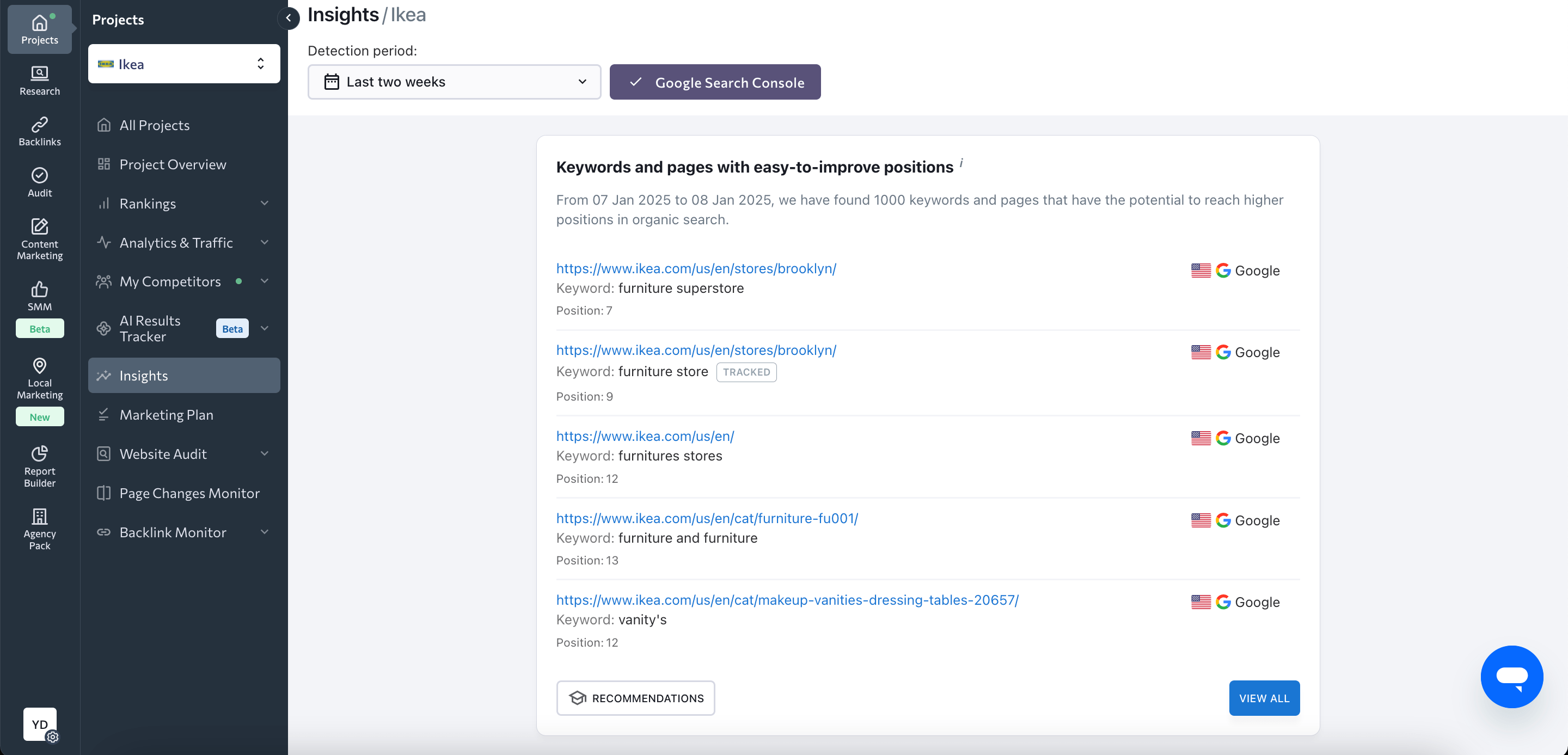
To collect these insights automatically, just create your project on the SE Ranking platform and authenticate it with the Google Search Console. The system will handle the monitoring automatically and spot attention-worthy events in a straightforward, easy-to-use format within the tool.
Each insight section includes a dedicated Recommendations block with practical steps to help you achieve quick SEO results.
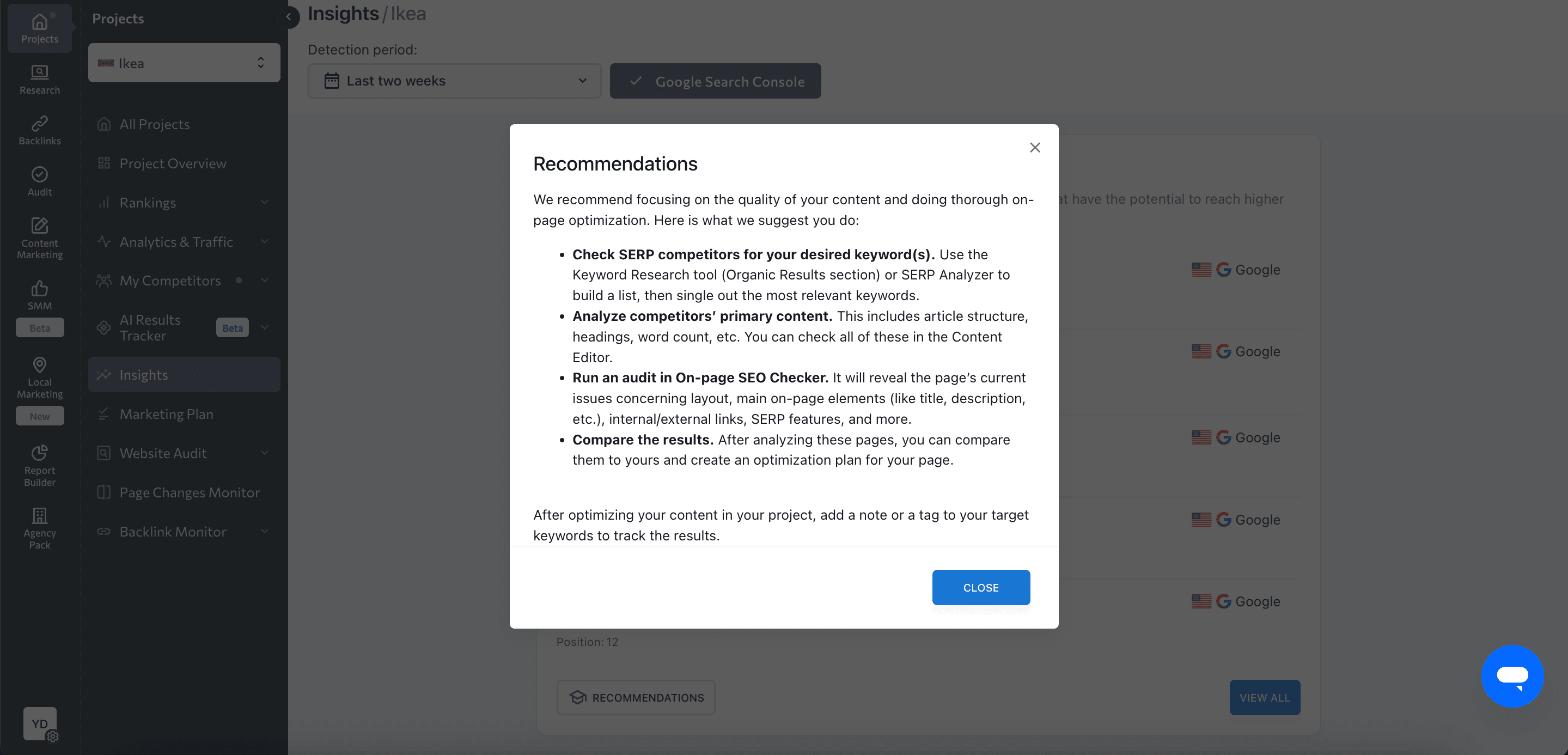
Perform technical audits to find quick fixes
Technical SEO issues can severely impact search performance, but many high-severity problems are easy to fix.
High-severity issues with simple solutions
By performing in-depth technical audits and applying targeted fixes, you can see a quick improvement in both rankings and user satisfaction.
Some technical issues worth prioritizing include:
1. Crawlability and indexing issues
- Broken links (404 errors): If unintentional, restore the pages. If expected, remove internal links to them or set up 301 redirects to relevant pages.
- Non-indexable pages: Use Google Search Console or SE Ranking’s Website Audit Tool to check for blocked pages and see if restrictions work as planned. Adjust the noindex instructions if they don’t.
- Crawl errors: Resolve crawl errors by fixing blocked resources or server errors.
- Orphan pages: Add internal links from relevant pages to ensure orphan pages are discoverable.
2. Redirect issues
- Redirect loops: Clear your browser cache and cookies, and check server-side settings like the .htaccess file, SSL configuration, and CMS settings for any conflicting redirects. If the issue persists, identify it by reviewing any plugins, custom code, or server-side rules that might be causing the loop. Then disable them one by one.
- Excessive redirect chains: Minimize redirects by linking directly to the final destination URL, eliminating unnecessary steps.
3. Site performance and usability
- Slow page load speed: To check for performance issues, test your website speed using PageSpeed Insights or SE Ranking’s Site Speed Test. Then, boost your site speed by compressing images, enabling browser caching, using a Content Delivery Network (CDN), and optimizing server response times for faster loading.
- Mobile usability issues: Most users browse the internet from smartphones, which is why Google has switched completely to mobile-first indexing. Test your site’s mobile usability, then fix issues related to viewport settings, text size, touch elements, and on-screen content.
4. XML sitemap issues
- Robots.txt file missing XML sitemap: Add a link to your XML sitemap file to the robots.txt file.
- Pages with the noindex meta tag in the XML sitemaps: Remove the noindex meta tag from the XML sitemap to allow search engines to index those pages.
- HTTP URLs in their XML sitemaps: Update the XML sitemap to use only HTTPS URLs to ensure secure and correct indexing.
For more sitemap optimization tips, read our in-depth guide on how to fix common XML sitemap issues.
SE Ranking’s Website Audit Tool is excellent for finding technical SEO issues. Its scoring system prioritizes problems by severity, giving more weight to critical issues.
It also looks at each issue’s scope. This means that problems affecting larger portions of a site will impact the health score more than problems limited to only a few pages.
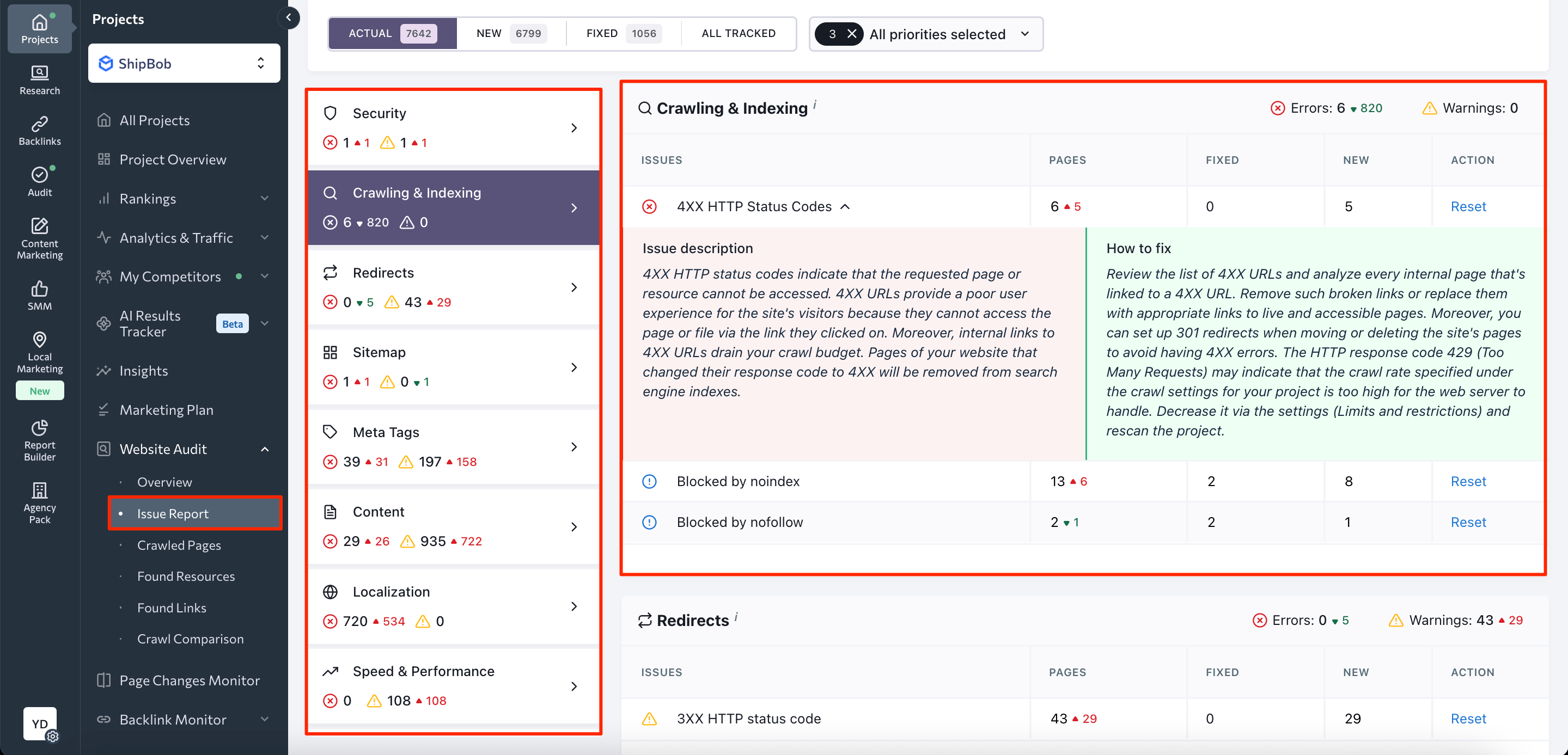
The tool organizes detected issues into sections, including Security, Crawling & Indexing, Redirects, Sitemaps, and more. This makes it easy to navigate and pinpoint problems with quick but meaningful fixes.
Widespread issues throughout the website
Issues that persist across multiple pages may relate to functionality, design, or user experience. The good news is that many of these can be resolved with a single fix across all affected pages.
1. Page element issue
Problem: A single mistake in a template’s layout can spread across all pages that rely on it. For instance, if the HTML template contains invalid <head> elements—such as improperly closed tags or unsupported meta tags—it can disrupt how search engines interpret the page. Crawlers encountering this may prematurely close the <head> section, and mistakenly assume the <body> has begun. This could cause it to ignore or incorrectly process crucial metadata like title tags, descriptions, and structured data, potentially harming all affected pages’ SEO.
Solution: Check your website for page element issues. If you find any, fix them directly in the template’s source code. This ensures each correction automatically applies to all affected pages, which results in proper metadata processing by search engines and better SEO performance.
2. Site-wide element issue
Problem: Websites occasionally have inconsistent or broken navigation elements. The header, footer, and sidebar menus may have broken links or non-responsive mobile navigation.
Solution: Modify the main navigation menu template (or CMS settings) to make it more user-friendly, responsive, and consistent site-wide.
3. CMS configuration issue
Problem: Improper CMS or plugin configuration issues can occasionally cause widespread issues. Common problems include improper generation rules for titles, meta descriptions, and canonical URLs. Some more issues include misconfigured robots.txt files and incomplete XML sitemaps. Broken breadcrumbs, missing or incorrect schema markup, and issues with automatic redirects or pagination can lead to poor user experience, duplicate content, or search engines struggling to understand or index key page elements.
Solution: Resolve these issues by fixing them in the core template or CMS configuration, which will apply the solution across all pages affected. Audit and update your CMS settings and plugins to handle any errors, and test new configurations before deployment.
Implement low-effort on-page SEO fixes
This section looks into when and how to perform on-page SEO activities to achieve quick SEO results.
Keywords and pages with major declines in impressions or clicks
Pay close attention to pages with drastically declining impressions or clicks. This suggests the page is no longer as relevant or visible in the SERP as it once was.
These pages are important because it’s easier to recover previously high-ranking URLs than create content from scratch.
It’s always possible to spend time manually searching for these pages (and their keywords) in Google Search Console. But you can also use SE Ranking’s Insights Tool to monitor your performance for them. It also regularly highlights big changes.
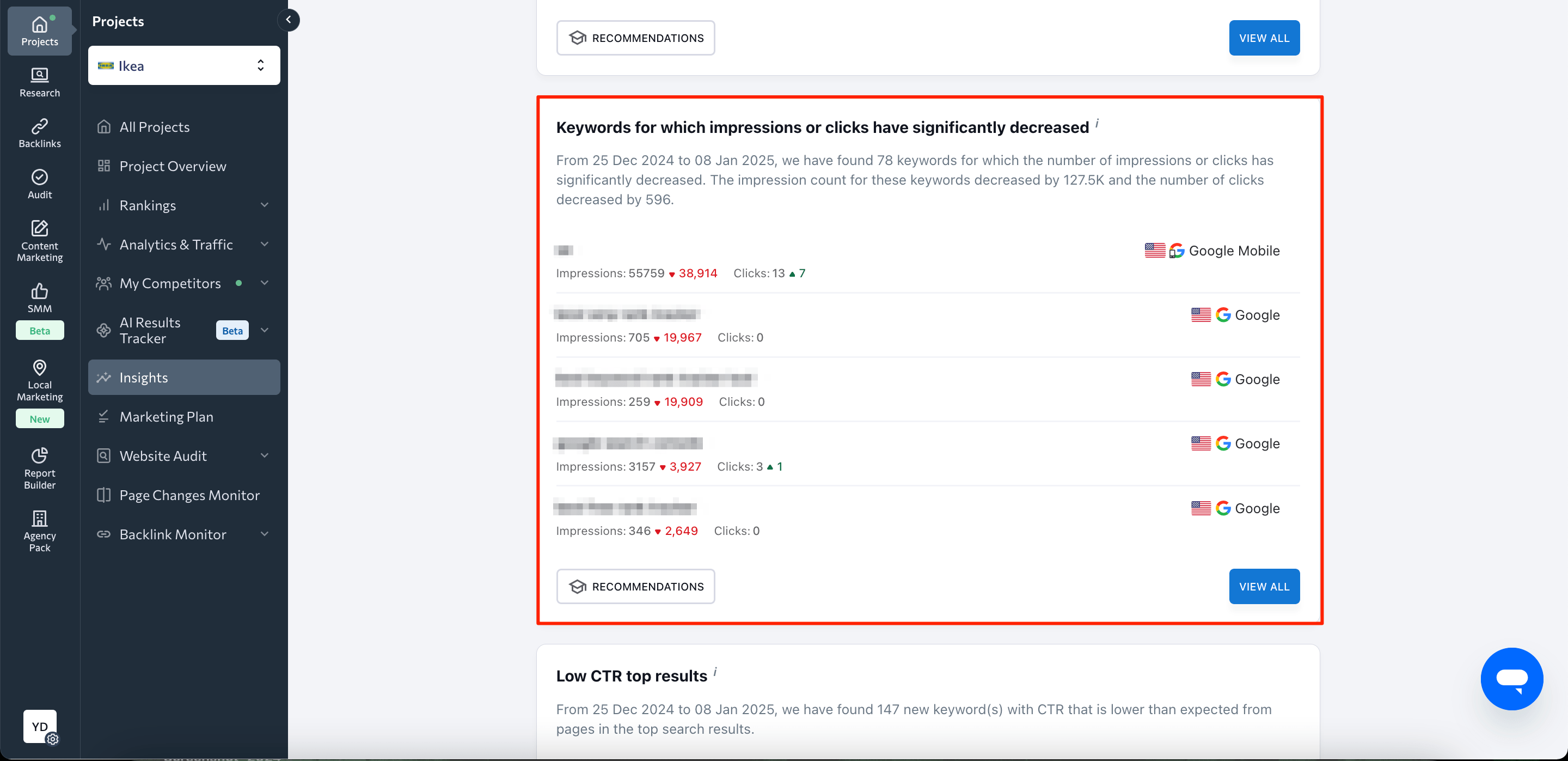
After creating your list, begin diagnosing performance drops—whether due to changes in search intent or competition. In many cases, adjusting each page’s keyword targeting, updating outdated content, and ensuring the content brings value can quickly help restore its performance.
You can also check for shifts in user intent or new, emerging search queries related to your niche. This keeps you ahead of trends so you can adapt your content to your target audience’s changing needs.
Low CTR top results
Even if a page ranks high in search, it can’t benefit your website unless searchers are clicking on it. Analyze pages with a strong ranking but a low CTR to identify performance improvement opportunities. SE Ranking’s Insights Tool automatically highlights pages with a lower-than-expected CTR in the top search results.
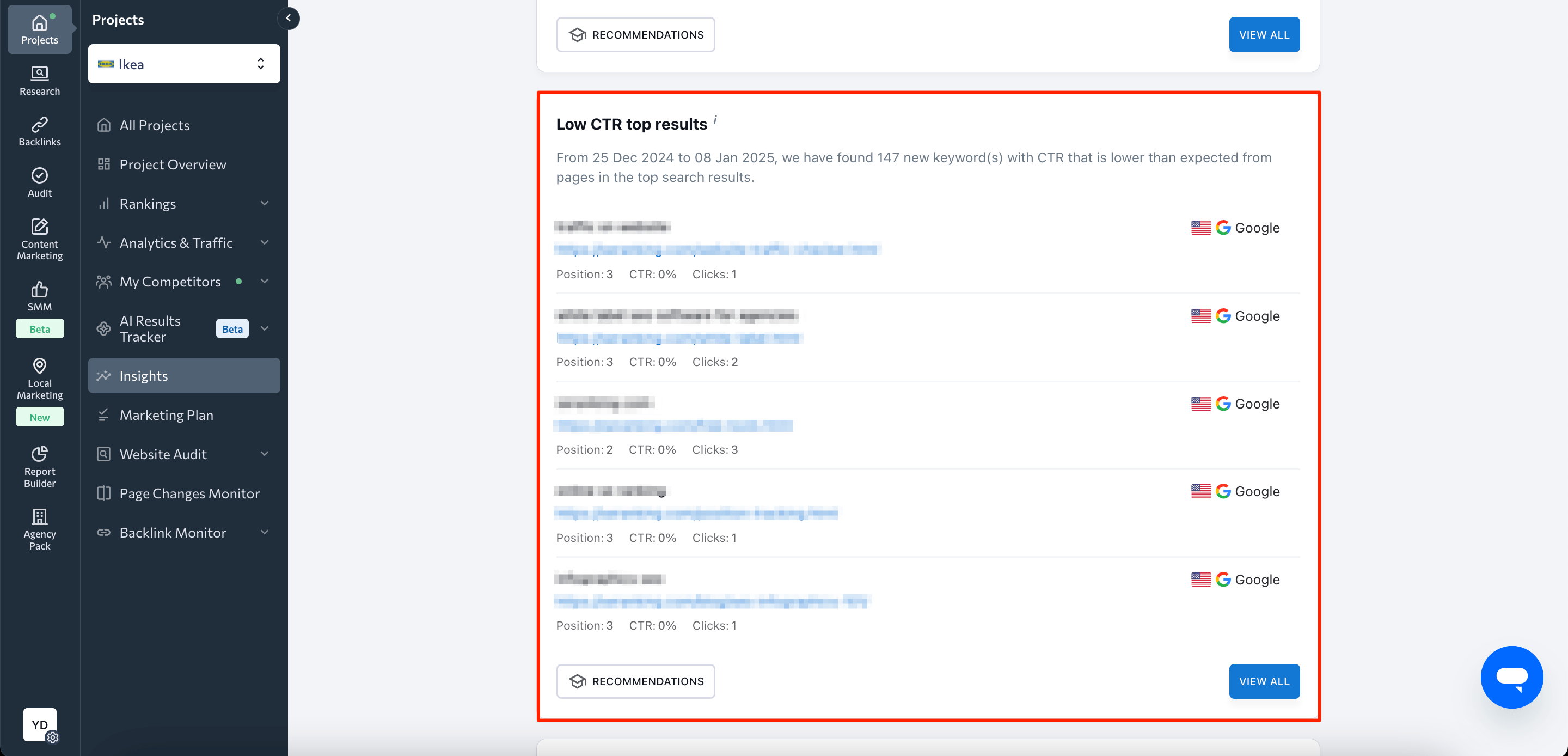
You can make these pages more appealing by tweaking meta titles and descriptions so that they better align with search intent and stand out in crowded search results.
Consider A/B testing different variations of meta descriptions and titles to see which one leads to higher engagement. Another approach is to add schema markup, like star ratings or product information, if applicable. This can make your page eligible for rich results, helping it stand out visually.
A key aspect of improving CTR is understanding user psychology. Does your title and description clearly explain the value of clicking? Does your SERP content pique user curiosity or hint at a solution to their search query?
Drive higher engagement and boost CTR by updating title tags and meta descriptions based on performance data, keyword trends, or changes in user intent.
Pages with poor-quality content
SE Ranking’s Insights Tool highlights pages that have a content score lower than 60 or a score that’s worse than the average of other competitors in the top 10.
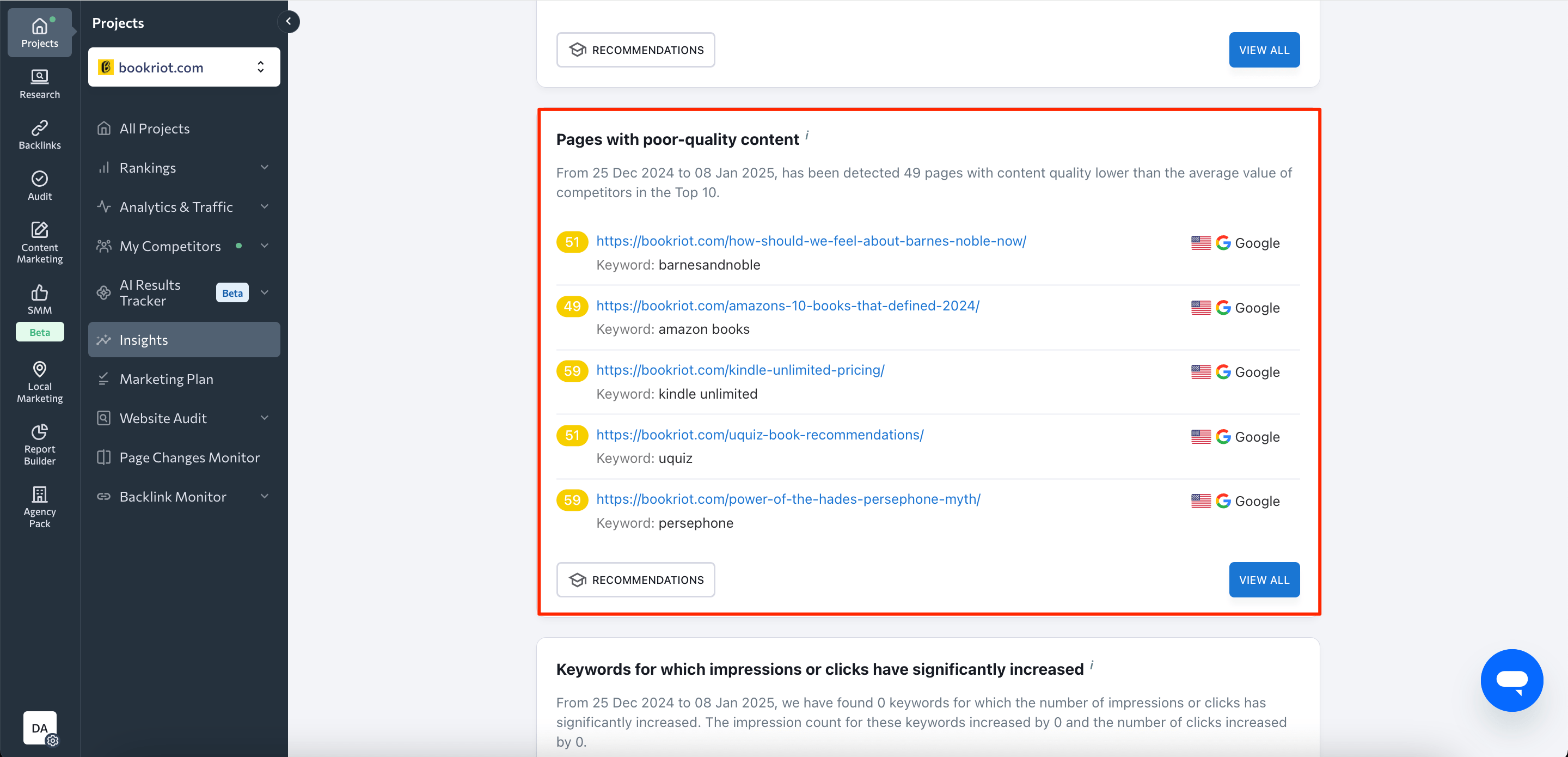
Each instance of poor content requires personalized attention and improvement. For specific guidance on enhancing your content quality, use our Content Editor. It compares your page’s content to top-performing pages and provides actionable suggestions to improve both the technical and semantic SEO aspects (e.g., adjusting word count, refining keywords, improving readability, etc).
But no matter what, always make sure your content aligns with E-E-A-T (Experience, Expertise, Authoritativeness, and Trustworthiness) principles. This is even more crucial for YMYL (Your Money Your Life) pages, where trust and credibility are paramount. Thorough, insightful, and expertly written content ranks better and engages visitors longer.
These are good starting points that need to be built upon to achieve sustainable, long-term results. Perform a content audit to get started.
Use internal links for high-converting and near-top pages
Internal linking is a powerful, multifaceted strategy. It hints to search engines how important certain pages are. It also impacts both your site’s crawlability and user experience.
Give these pages the push they need by linking to them from relevant, high-authority pages on your site. This passes valuable link equity to them and helps them rank high.
Keep the anchor text to these links relevant and natural to make the linked page’s context easy for users to understand. It’s also helpful to link to these pages from other content on your site that covers similar or related topics. This provides additional context and relevance.
Here are two quick SEO tips for using internal links more effectively:
1. For pages nearing the top 10
Identify pages ranking just outside the top 10 search results (positions 11-20). These pages are close to gaining more search visibility and only need a little boost to get higher rankings.
2. For high-converting pages
Internal linking also boosts conversions by guiding visitors to pages where they’re most likely to take desired actions, like making a purchase or signing up. By linking to high-converting pages from multiple relevant locations, you can improve their visibility in search results and make it easier for your visitors to find them.
Here are some things you would do if you had a successful service page with a high conversion rate:
- Link to it from related blog posts
- Reference it in high-ranking pages
- Include it in relevant navigation menus (e.g., footer, header)
- Add contextual links from complementary product pages
But traffic alone doesn’t guarantee success. You also need to figure out how to direct it using internal linking and conversion-focused content.
Rebuild lost backlinks to get higher traffic and better rankings
Losing high-quality backlinks results in less organic traffic and reduces overall SEO performance. Regain lost backlinks by reaching out to the site owners and content creators whose links you’ve lost, reestablishing your connection by offering to update or provide valuable resources.
SE Ranking’s Backlink Monitoring Tool is a valuable resource for identifying lost backlinks. It performs regular checks and provides detailed insights into your backlink profile. Here are the metrics it tracks:
- The number of backlinks earned and lost over various time periods.
- The ratio of backlinks to your homepage over other pages.
- The balance between dofollow and nofollow backlinks.
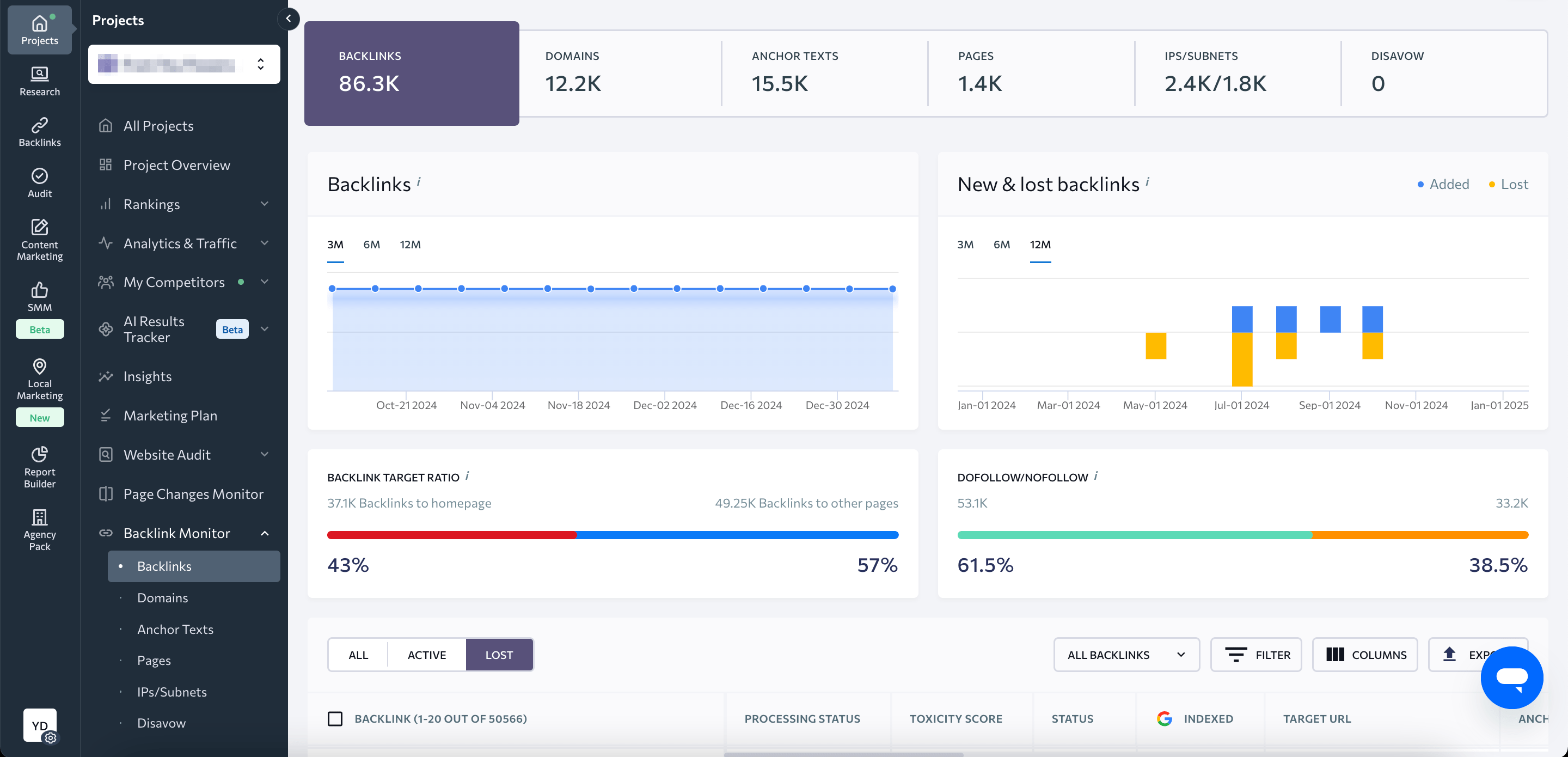
The bottom line? Closely monitor your lost backlinks and always prioritize reclaiming them.
Target high-converting keywords in your content
When selecting keywords, focus on high-converting ones. Long-tail keywords, for example, indicate clear intent. Target these if you’re looking for users who are actively looking for solutions.
Long-tail keywords typically have lower search volumes than basic short-tail queries, but they also have lower competition (which makes them easier to rank for). Long-tail keywords also tend to have higher conversion rates.
Keyword suggestion tools like SE Ranking’s Keyword Research or Google’s Keyword Planner are great tools for identifying low-competition keywords.
You also need to focus on search intent. Transactional and commercial keywords, for example, target users who are more likely to convert and make a purchase.
Let’s say someone searches for the “best take out gluten-free pizza near me.” This is a commercial keyword with clear intent, making it highly valuable for relevant local businesses. Phrases like “buy outdoor running shoes for men” indicate clear transactional intent, where the user is ready to make a purchase (ideal for e-commerce websites).
Create (and claim) your Google Business Profile
If you’re a local business, create a Google Business Profile (GBP). You’ll need it to establish and improve your online presence. Keeping your GBP optimized helps it appear on Google Maps and improves its visibility in search results.
Another perk is that you can get your client’s business to appear on Google Maps in as little as 5 business days once you’re finished with GBP verification.
Complete it thoroughly for the best results. Provide key details for customers, including your hours of operation, contact information, business description, and the link to your website. Add high-quality images of your business, products, and services to boost user engagement.

Another critical aspect of local SEO is NAP consistency, which keeps your business’s name, address, and phone number consistent across all online directories, websites, and social media platforms.
Inconsistent NAP data across various platforms can confuse search engines. Customers may also become skeptical of your business if they encounter inconsistent details about it throughout the web.
To improve your local SEO efforts, consider using specialized tools like SE Ranking’s Local Marketing Tool. It tracks local rankings on a grid-based map and does an audit of your listings on multiple local directories.

Additionally, you can gather customer reviews from 30 different platforms. These include large platforms like Google, Facebook, Yellowpages, and TripAdvisor. It also uses what it finds from these platforms to generate AI-powered insights about your business.
You can also use it to create custom reports that showcase your progress in local SEO.
Bonus tip: Use paid ads for immediate results while building long-term SEO
Paid advertising is a quick but reliable way to test and validate keyword effectiveness. For instance, if you notice in your ads that one keyword specifically is generating a ton of clicks and conversions, it’s probably worth optimizing for. Start creating content around it and improving organic rankings for that term.
Combining SEO and paid advertising is an effective way to launch new products. SEO gradually builds awareness and demand for your new services, while paid ads drive immediate traffic to your landing pages for those products.
This is an ideal approach if you want to achieve top organic rankings in competitive markets.
You’ll need to start by setting up a low-budget Google Ads campaign that targets local keywords.
This helps generate leads for your client within the first few weeks. Although this strategy might cost quite a bit or shorten margins in the early months, it builds trust and enthusiasm. Once organic rankings and local listings gain traction, you can taper off the ads and transition to a more sustainable, SEO-driven growth strategy.
To sum it up
Growing your SEO organically takes time and consistency, but the techniques in this post help you get meaningful results faster.
Use them to prove your value to clients when it comes to getting those quick SEO wins. Showing meaningful progress in as little as a few days or a couple of weeks proves to your client that SEO can also be effective in the short term when done right.

